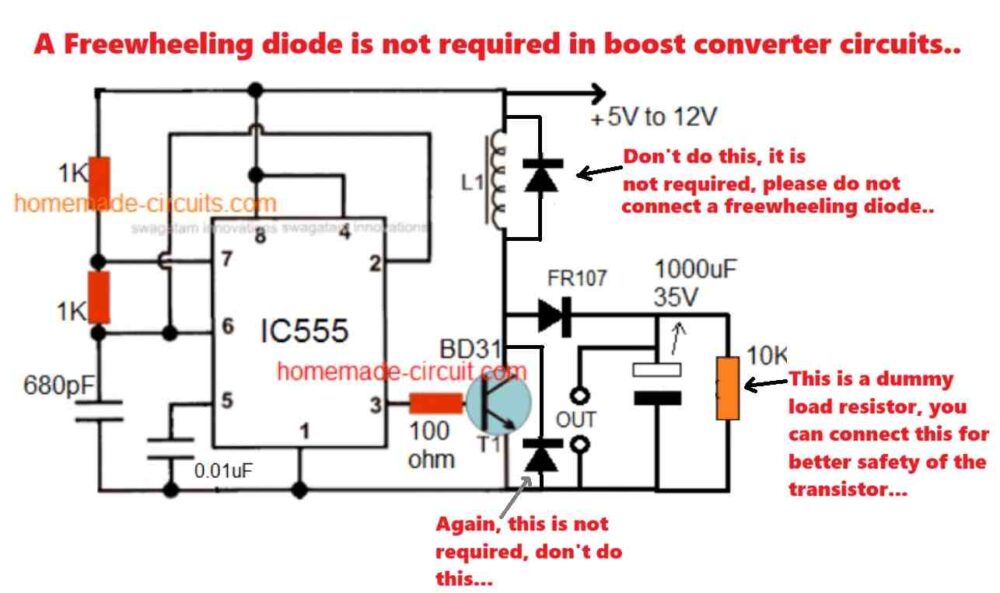So here we are trying to understand whether we must put a freewheeling diode directly across the inductor in a boost converter or not, to safeguard the switching transistor?
How Boost Converter Works
So in a boost converter, we got one inductor, one power switch like a MOSFET, one diode and one output capacitor. Input is from DC source like 12V.
When MOSFET switches ON then current from the DC source flows through inductor and charges it, energy goes inside inductor in magnetic form. During this time, diode is reverse biased so it does not conduct, load gets power from output capacitor.
Then, when MOSFET switches OFF, the inductor wants to keep current flowing and since MOSFET is OFF now, the diode becomes forward biased and all that energy from inductor pushes ahead through the diode and charges the output capacitor and powers the load. This is how voltage gets boosted.

What Happens if We Add Diode Across Inductor?
Now suppose we add one freewheeling diode across the inductor directly. That means the diode cathode goes to one side of inductor and anode to other side.
When MOSFET turns OFF then this diode will try to conduct and give inductor an alternate path. So now instead of pushing current to output, the inductor will dump energy back to itself via this diode loop, and whole boost effect is gone. So output never gets boosted.
That diode becomes a short cut path and kills the boost action.
What About No Load Condition?
Now some may ask what happens if there is no load at output? Like when nobody is drawing current. Will inductor flyback cause damage to the transistor?
Answer is no, because the inductor already has a proper flyback path through the output diode and capacitor. Even if load is zero, energy still goes to output capacitor.
Voltage might increase slightly if output cap is small but no harm to components. If you are too worried then just add some dummy load like a resistor at output to soak some charge.
No Load Can Still Be Risky in Some Cases
So when we say "risky without load," it does not mean the boost converter will immediately blow up. What we mean is — under no-load condition if the output capacitor is too small or the feedback loop is not smart then yes, voltage can keep rising and rising with each switching cycle because nobody is there to consume that extra energy. This can push the output voltage above safe limits.
But… that does not mean you need to put a freewheeling diode across the inductor. That would totally ruin the boost process like we discussed. The solution is not diode, but to:
Make sure you have a decently rated output capacitor (big enough to absorb temporary excess energy).
Use a minimum dummy load resistor if your circuit allows, just to drain some charge if nothing else is consuming.
Most importantly, have a proper feedback system (PWM control) that senses output voltage and stops boosting once target is reached.
So yeah — it is not dangerous because of inductor not having flyback path (that is already handled by output diode), it is dangerous if you have bad control or no feedback in no-load cases.
Conclusion
So in short, never put any freewheeling diode directly across the inductor in a boost converter. It will kill the boost process. That diode is not needed. Instead, always make sure output diode and capacitor are there and properly connected, along with a small dummy load. That is all we need for safe operation.
Need Help? Please Leave a Comment! We value your input—Kindly keep it relevant to the above topic!